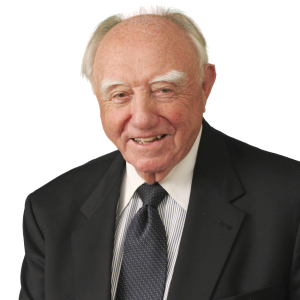Media Source: Newsday

Joseph Suozzi
Age: 85
Home: Glen Cove
Military service: Served aboard a B-24 during World War II
Long before he became an influential player in Nassau County political and legal circles, Joseph Suozzi was a 22-year-old crewman clad in a heated suit, flying B-24 Liberators over Europe during World War II.
During eight months in 1944 and 1945, Suozzi flew 35 missions over Germany, Austria, Yugoslavia and Italy as the navigator. He earned the Distinguished Flying Cross, which rests in a frame in his office along with five other service medals.
Suozzi says he doesn't keep his medals on a wall at home because 'I wouldn't know where to put them.
'I don't dwell on it, and I don't try to go back in the past,' he said, adding with a wry smile, 'partly because I don't remember some of it.
'But I don't think that I would be the man I am except for that experience.'
Now 85, Suozzi, a former judge and Glen Cove mayor, still works about seven hours a day at the Garden City law firm Meyer Suozzi English & Klein. His son, Nassau County Executive Thomas Suozzi, recently lost the Democratic primary for governor to Eliot Spitzer.
Joseph Suozzi was a student at Fordham University when he decided to volunteer during World War II to become an air cadet. He was able to complete his undergraduate degree and then enter the U.S. Army Air Corps. He flunked pilot training but volunteered for navigators school. Soon, he was off to Italy, the country of his birth, where his crew was based.
The Liberator carried five machine guns and had a top speed of 290 mph. It was 110 feet from wing to wing, and 67 feet long.
'It was just a big crate,' Suozzi said. 'It always surprised me that the thing could get up in the air.' The 10-member crew targeted factories, railroads, oil facilities and other industrial targets. Flying at 30,000 feet, it got so cold the crew members wore heated suits.
'In those days, you did what you were supposed to do, and you didn't ask many questions,' he said. As navigator, Suozzi didn't have advanced radar systems. 'We used celestial navigation,' he said. 'It taught where you've been, not where you were. You were always about an hour behind. You looked at the ground, and you looked at maps.' The plane performed both solo and multiple plane raids. 'Sometimes you'd have 100 planes up there in formation above the clouds,' Suozzi said. 'It was a spectacular sight.'
But, he said, there were a couple of hairy experiences. In one case, after delivering gasoline to Gen. George Patton's Army, the bomber almost ran out of gas and landed on fumes. In another case, the plane was attacked by anti-aircraft guns and enemy planes. 'One engine was hit, and we were forced to land just inside our lines,' he said.
After the war, on advice from a friend, Suozzi applied to Harvard Law School and was accepted.
He graduated in June 1948, passed the bar that July and was admitted in November. At 28, he was elected to the bench of the City Court of Glen Cove. Five years later, he ran for Glen Cove mayor, won and was re-elected twice. He then won a race for State Supreme Court justice, and, in 1976, was appointed associate justice of the Appellate Division. In 1980 he joined the law firm.
Like many veterans who experience war firsthand, Suozzi follows developments in Iraq.
'I don't know where we're going,' he said. 'We're really in a quandary. We can't really give it up and walk away. We have to make do the best we can. Hopefully, we'll find a formula for winning this thing. There've been a lot of lost lives and sacrifices, and a lot of money that could have been spent on other things.'
990 Stewart Avenue, Suite 300,
Garden City, NY 11530
750 Ninth Street, Suite 501
Washington, D.C. 20001
Phone(202) 887-6726Fax:(202) 223-0358


